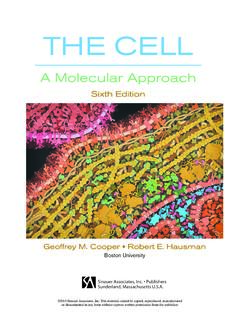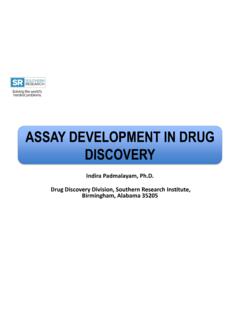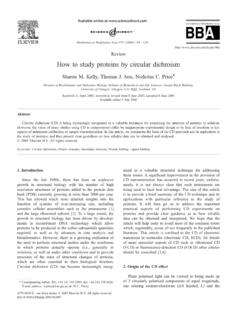Transcription of Enzymes: The Biological Catalysts of Life - EOLSS
1 UNESCO EOLSSSAMPLE CHAPTERSPHYSIOLOGY AND MAINTENANCE Vol. II enzymes : The Biological Catalysts of life - Pekka M nts l and Jarmo Niemi Encyclopedia of life Support Systems ( EOLSS ) enzymes : THE Biological Catalysts OF life Pekka M nts l and Jarmo Niemi University of Turku, Department of Biochemistry, Finland Keywords: enzymes , specificity, catalysis, cofactors, enzyme turnover, enzyme applications. Contents 1. Introduction 2. enzymes as Biological Catalysts Factors Affecting Activity Active Site Enzyme Kinetics Specificity Mechanism of Action Regulation of Enzyme Activities 3.
2 Cofactors 4. enzymes in the Cell 5. Enzyme Turnover 6. Enzyme Nomenclature Reaction Types Isoenzymes 7. Clinical and Biotechnological Applications of enzymes Clinical Enzymology Biotechnological Applications Glossary Bibliography Biographical Sketches Summary The function of Catalysts is to speed up reactions without becoming a part of the reaction products. enzymes , the Biological Catalysts are highly specific, catalyzing a single chemical reaction or a very few closely related reactions. The exact structure of an enzyme and its active site determines the specificity of the enzyme.
3 Substrate molecules bind themselves at the enzyme's active site. Substrates initially bind to the enzymes by non-covalent interactions, including hydrogen bonds, ionic bonds and hydrophobic interactions. enzymes lower the activation energy and the reactions proceed toward equilibrium more rapidly than the uncatalyzed reactions. Both prokaryotic and eukaryotic cells commonly use allosteric regulation in responding to changes in conditions within the cells. Allosteric regulation can be positive or negative.
4 Regulation by allosteric inhibitors is common in many biosynthetic pathways. A protective peptide in zymogens regulates by inactivating the protein. Zymogens are proteolytically activated. Catalytic activity of some enzymes may be regulated by cofactors. Metal ions or other small molecules serve as the cofactors. Some enzymes contain tightly bound cofactors termed prosthetic groups. Protein degradation is also UNESCO EOLSSSAMPLE CHAPTERSPHYSIOLOGY AND MAINTENANCE Vol. II enzymes : The Biological Catalysts of life - Pekka M nts l and Jarmo Niemi Encyclopedia of life Support Systems ( EOLSS ) one central way to regulate the enzyme levels.
5 Hundreds of enzymes are commercially available. Some of these have increasing importance in industry and in medical and clinical applications. 1. Introduction enzymes are proteins functioning as Catalysts that speed up reactions by lowering the activation energy. A simple and succinct definition of an enzyme is that it is a Biological catalyst that accelerates a chemical reaction without altering its equilibrium. During the reactions the enzymes themselves undergo transient changes. In the overall process, enzymes do not undergo any net change.
6 The enzyme Catalysts regulate the structure and function of cells and organisms. They catalyze the synthesis and breakdown of biochemical building blocks and macromolecules, the transmission of genetic information, the transport of compounds across the membranes, motility of organisms and conversion of chemical energy. Enzyme catalysis is essential for making biochemical reactions proceed at appropriate speed in physiological conditions. They speed up the reactions in the cells so that they may occur in fractions of seconds.
7 In the absence of Catalysts most cellular reactions would not occur even over time periods of years. Without rapid cellular reactions life in its present form would not be possible. One characteristic feature of enzymes is their specificity. Thus each reaction in the cell is catalyzed by its own, specific enzyme. The substances that are acted upon by enzymes are substrates. Substrate can be a small molecule or a macromolecule like an enzyme itself. For example, trypsin is the enzyme that uses polypeptides as the substrate and hydrolyses the peptide bonds.
8 The exact number of different enzymes in various cells is not known. However, because the number of different reactions in the cells of higher eukaryotes is in the tens of thousands, the number of different enzymes in the cells has to be in the same scale. Based on results of the genome sequencing projects, the estimated number of enzymes in the cells is now much more accurate than before these sequencing projects were initiated. For example, in an Escherichia coli cell, there are roughly 4300 proteins and almost 3000 of them are enzymes .
9 Mammals have more than ten times the number of proteins and enzymes than there are in E. coli. enzymes have been utilized for thousands of years in microbial processes. Microbes and their enzymes have been applied for preparation of wines, beer, cheeses and other milk products. The role of enzymes in the fermentation process has been known for less than two hundred years. In the 1850s Louis Pasteur presented a theory that sugar is converted into ethanol in yeast by "ferments". He also concluded that these ferments are inseparable from the living yeast cells.
10 At the end of the eighteenth century, more information on the nature of fermentation was obtained when Buchner was able to ferment using a yeast filtrate. Processes for the isolation of enzymes and studies of their properties were ready to start. The ultracentrifugation technique was applied for enzyme studies in the 1920s. These studies revealed the physical nature of the enzymes . Solving the amino acid sequence of ribonuclease gave the enzyme structure in chemical terms. The 3-dimensional structure of lysozyme was solved in 1965 by using X-ray diffraction analysis.

















